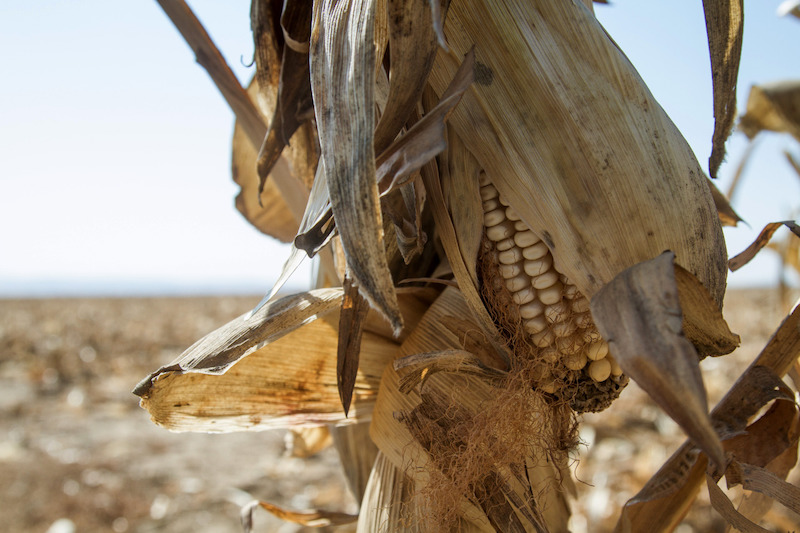El Nino may see first S. Africa white-corn import since 2017
South Africa may import significant amounts of white corn, used to make a staple food, for the first time since 2017 as the El Nino weather pattern withers the crop, the chief economist for the main farming business association said.
Dry and unseasonably hot weather that’s persisted across much of the country so far this year has slashed forecasts for the size of the harvest. The government’s Crop Estimates Committee on Tuesday slashed its outlook for the white-corn crop by 11% to 6.28 million tons, while the overall take that includes the yellow variety is projected at a five-year low of 13.26 million tons. Corn is known as maize in South Africa.
If the dry weather persists, the harvest will fall further as the plants are currently pollinating and need the moisture, said Wandile Sihlobo, chief economist at the Agricultural Business Chamber of South Africa.

“If white maize is lowered further we may have to import, which would be the first time since the last tough drought,” he said in a response to queries. The reason our crop is down is purely the El Nino-induced drought.”
The potential shortage of white corn compared with yellow corn, which is readily available internationally, is seeing the yellow variety trade at a 20% discount to the white variety on the South Africa Futures Exchange in Johannesburg, whereas a year ago they were roughly the same price. That’s the biggest spread between the two prices in about 20 years.
The generic first future for white corn closed trade at 5,340 rand ($282) per ton on Wednesday while yellow corn traded at 4,293 rand. White corn has gained 37% over the past year while the yellow variety has risen 5.5%.
El Nino, which causes oceans to warm, usually triggers drier weather in southern Africa, reducing crop yields and pushing temperatures higher. La Nina, which usually follows El Nino periods, results in the opposite.
The white variety of the grain, used to make corn meal known locally as pap, is eaten across southern Africa while much of the rest of the world relies on the yellow type, which South Africans use for animal feed. The country is usually Africa’s biggest exporter.
That means in times of shortage, the southern African region has to rely mainly on Mexico and the US for imports. While yellow corn can be used as a substitute, it meets consumer resistance. Dry weather has also slashed crops in other southern African countries.
In the 2016-17 agricultural season, which runs to the end of April, South Africa imported 644,144 tons of white corn from the two north American nations, according to South African Grain Information Service data. Aside from 7,583 tons bought from Zambia in the 2021-22 season, it hasn’t imported white corn since.
South Africa’s corn production may improve next season, Sihlobo said.
“Toward the end of the season, from around about July, we will transition from an El Nino into a La Nina period,” he said. “Which is why some of us in South Africa are hopeful that the current drought will be short-lived.”
Similar Stories
United States and Norway issue innovative report creating greater transparency in critical mineral supply chains
Today, the U.S. Department of Commerce and the Norwegian Ministry of Trade, Industry, and Fisheries issued a thorough, innovative report presenting our shared understanding of non-market policies and practices (NMPPs)…
View ArticleDecember CNBC/NRF retail monitor results show strong growth boosted by final Thanksgiving weekend days
Retail sales jumped strongly in December, boosted in part by two busy holiday shopping days during Thanksgiving weekend falling in the final month of the year, according to the CNBC/NRF…
View ArticleNAW presents Dirk Van Dongen Lifetime Achievement Award to Bergman, CEO of Henry Schein, Inc.
At the 2025 NAW Executive Summit Gala on January 28 in Washington, D.C.
View Article
St. Louis region’s chemical industry welcomes new investment
View Article
Navigating compliance: Adapting to changing Customs regulations in global supply chains
View Article
December 2024 U.S. Transportation Sector Unemployment (4.3%) Was the Same As the December 2023 Level (4.3%) And Above the Pre-Pandemic December 2019 Level (2.8%)
View ArticleGet the most up-to-date trending news!
SubscribeIndustry updates and weekly newsletter direct to your inbox!





